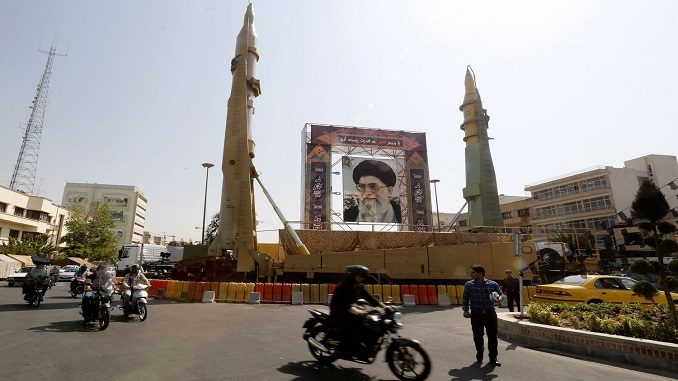
In a last-ditch attempt to prevent President Donald Trump from exiting the Iran nuclear deal, European leaders have finally promised to work with the United States to address Iran’s ballistic missile program. If Trump is serious about fixing the deal, the transatlantic working group now tasked with forming a common U.S.-EU position must produce nothing less than a commitment to reimpose tough sanctions on Iran should the regime’s missile development and testing continue, Foreign Policy reports.
Iran’s ballistic missile launches and transfers have been a growing source of tension between the United States and Europe over the last year. Since February 2017, the U.S. Treasury Department has imposed sanctions on at least 60 people and companies for their support of Iran’s missile and military programs. The EU Council, by contrast, has not issued a single designation of this sort since inking the nuclear deal, or Joint Comprehensive Plan of Action (JCPOA), in July 2015. Rather, European leaders have selectively lent support to the U.S. position through official statements and joint condemnations.
While some JCPOA supporters believe this U.S.-EU gap can be bridged by embracing Iran’s recent pledge to limit the range of its missiles to 2,000 kilometers, Trump would be correct in calling that a sham. With talks between American and European diplomats slated to commence, Washington must hold a thoughtful but hard-nosed negotiating position to achieve something real.
First, in discussion with its European counterparts, Washington should clearly establish why Iran’s ballistic missiles are a problem. According to multiple Directors of National Intelligence, Tehran boasts the Middle East’s biggest ballistic missile arsenal. This poses both a conventional and an unconventional threat, with many missiles exceeding the specifications that make them nuclear capable.
While the JCPOA failed to address this growing threat, the deal’s implementing UN Security Council resolution did, calling upon Iran “not to undertake any activity related to ballistic missiles designed to be capable of delivering nuclear weapons, including launches using such ballistic missile technology.” Iran continues to flagrantly ignore this and other demands contained in the annex of that resolution.
Second, with that baseline understanding of Iran’s missile program established, the two sides should develop a mutual assessment of the present and future Iranian missile threat. Washington and its closest European allies should exchange data and intelligence on the overall military effectiveness of Iran’s missiles, improvements in engine and re-entry vehicle design, as well as Iran’s embrace of solid propellants, which would increase the readiness and mobility of its missiles.
Washington should also make clear that Iranian attempts to produce or procure an intermediate-range or intercontinental ballistic missile would put the European continent at risk before the United States. Indeed, Iran’s growing missile inventory already indicates that the regime is interested in both ballistic and cruise missiles that could potentially strike southern Europe if fired from the fringes of Iranian territory.
Given U.S. and European defense commitments and deployments throughout the Middle East, neither side benefits from allowing Iran to perfect its existing stock of medium- and short-range ballistic missiles. These missiles not only bolster Iranian deterrence and coercion but also increase the likelihood of a mass-casualty regional conflict.
Third, the mutual threat assessment should lead the United States and the EU to develop similar goals with respect to Iran’s missile program. Even if Europe was tempted to embrace Iran’s 2,000-kilometer offer which would lock in rather than roll back the Iranian missile threat, Iran could still exploit a major loophole: using its satellite-launch vehicle tests as a cover to increase the range of its missile force. That means an agreement on this issue alone would end up just as flawed as the first deal.
Fourth, Washington should remind Europe that under the JCPOA, the United States and EU are on a collision course when it comes to sanctions against Iran’s missile program. Under the current deal, by no later than 2023, the EU must suspend its sanctions against the core of Iran’s missile industry, including Iran’s Ministry of Defense and its subsidiary, Aerospace Industries Organization (AIO).
It must also remove sanctions against two Iranian Aerospace Industries Organization subsidiaries, Shahid Hemmat Industrial Group and Shahid Bagheri Industrial Group — the latter being the very same entity that found its subsidiaries slapped with additional U.S. sanctions earlier this month. Europe must even suspend its sanctions against the Islamic Revolutionary Guard Corps’ Aerospace Force, which serves as the custodian of Iran’s diverse ballistic missile arsenal.
Easing financial pressure on Iran’s missile manufacturers while the regime seeks to further develop its missile program does not match Europe’s recent tough talk. If Europe genuinely sees Iran’s missiles as a threat, then the EU will commit to maintaining these sanctions indefinitely.
Finally, and perhaps most importantly, if Iran insists on defying the Security Council and continues ballistic missile flight-tests, the United States and Europe must agree that their toughest economic sanctions will not remain locked away forever. Europe and the United States should publically determine that nothing in the nuclear deal prevents either party from re-imposing sanctions waived by the deal for non-nuclear activities.
An effective and defensible U.S.-EU missile sanctions architecture can be rebuilt by designating any sector of the Iranian economy and any Iranian financial institution that is connected to its missile activities. Iran’s leaders clearly do not feel hamstrung by the JCPOA to expand its missile program. Likewise, the West should not feel hamstrung by the JCPOA to respond in kind.
